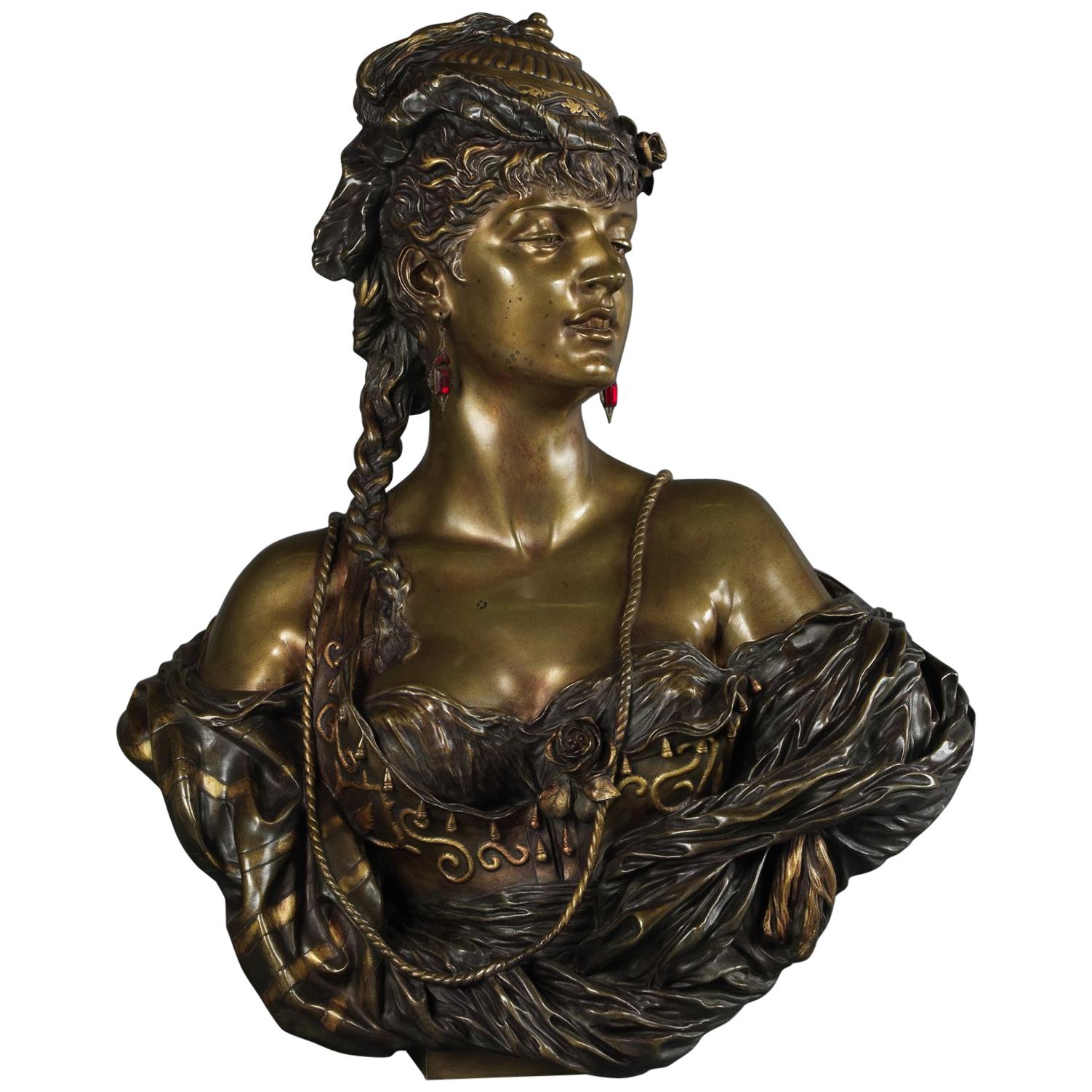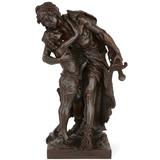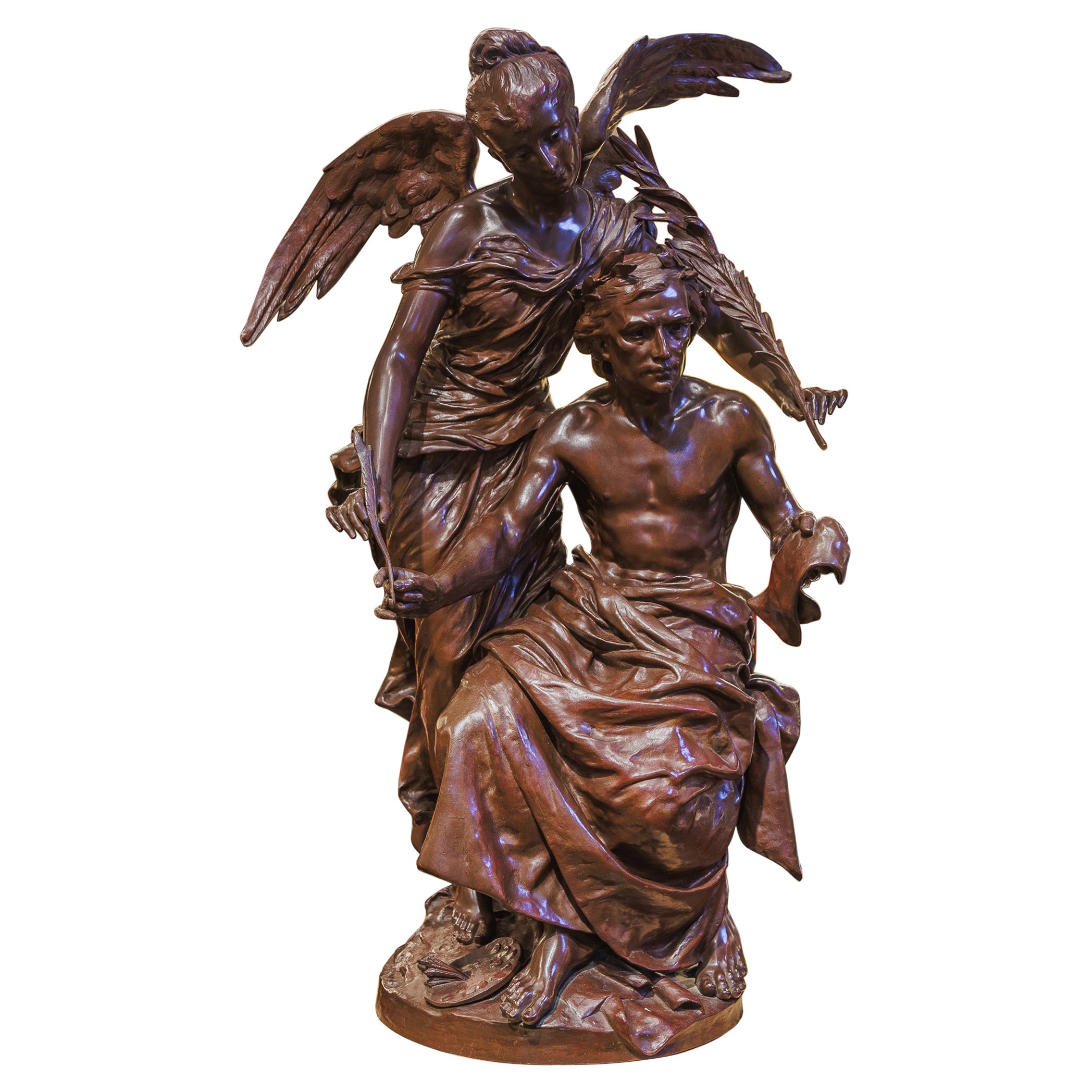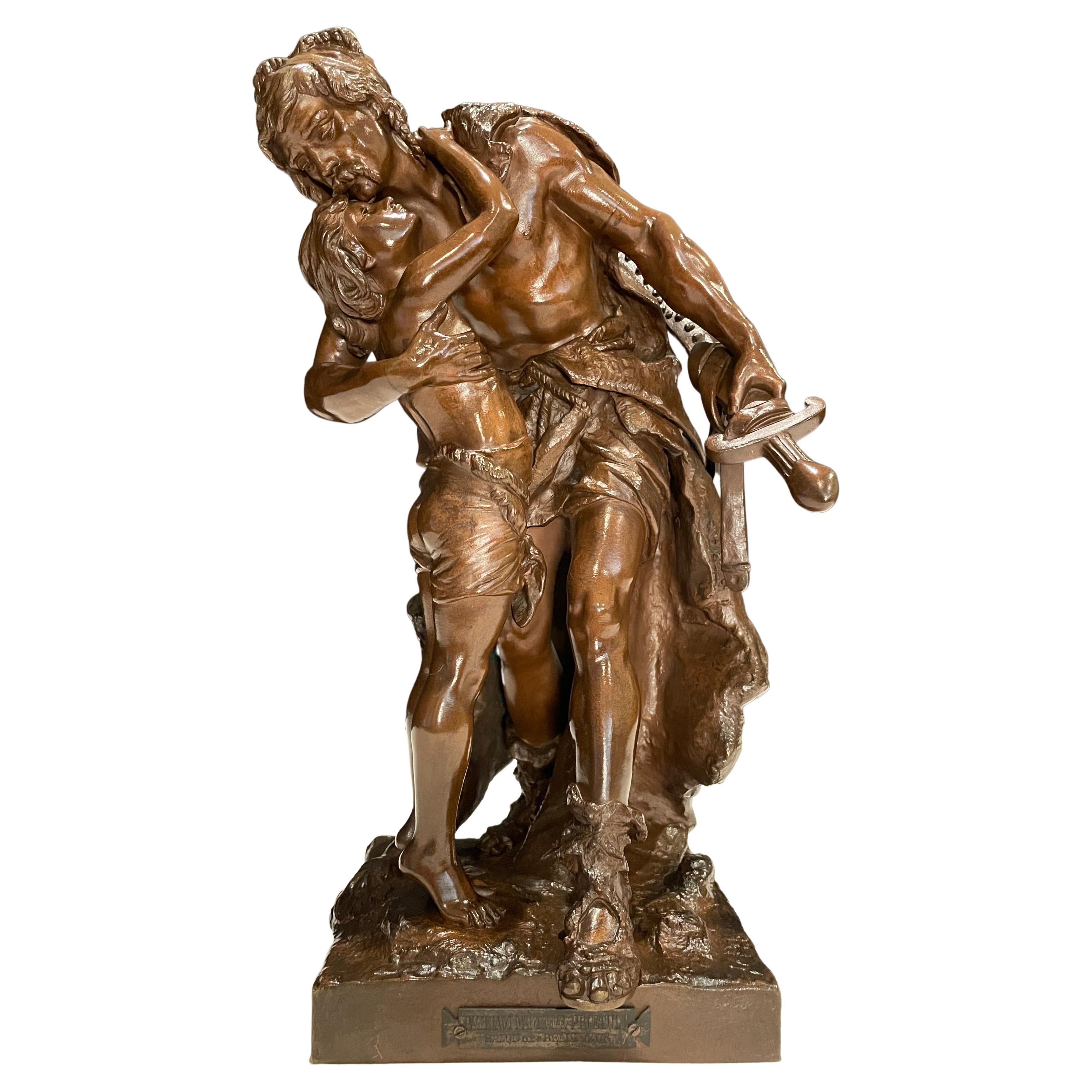Items Similar to Large Multi-Patinated Bronze Figure of an Arab Warrior by Henri-Honoré Plé
Want more images or videos?
Request additional images or videos from the seller
1 of 5
Large Multi-Patinated Bronze Figure of an Arab Warrior by Henri-Honoré Plé
About the Item
A Large and Important Multi-Patinated Bronze Figure of an Arab Warrior by Henri Honoré Plé.
Signed Henri Plé to the base.
The figure is finely modelled as an Arab warrior, with sword drawn and crescent tipped standard held aloft, with a rich multi-patinated patina heightened with gilding.
French, Circa 1880.
Henri Honoré Plé (1853 - 1922) studied under Gérault and Mathurin Moreau, and worked as a painter and sculptor of portraits and bas-reliefs. He exhibited at the Salon from 1877 onwards winning an honourable mention in 1879 before going on to receive a bronze medal at the Paris 1900 Exposition Universelle.
Bibliography:
Forrest, Michael. Art Bronzes, Schiffer Publishing Ltd, (Pennsylvania), 1998.
- Creator:Henri Honoré Plé (Sculptor)
- Dimensions:Height: 55.12 in (140 cm)Width: 21.66 in (55 cm)Depth: 19.69 in (50 cm)
- Materials and Techniques:Bronze,Patinated
- Place of Origin:
- Period:
- Date of Manufacture:Circa 1880
- Condition:Wear consistent with age and use.
- Seller Location:Brighton, GB
- Reference Number:
About the Seller
5.0
Recognized Seller
These prestigious sellers are industry leaders and represent the highest echelon for item quality and design.
Platinum Seller
These expertly vetted sellers are 1stDibs' most experienced sellers and are rated highest by our customers.
Established in 1964
1stDibs seller since 2014
48 sales on 1stDibs
Typical response time: 1 hour
Associations
The British Antique Dealers' AssociationLAPADA - The Association of Arts & Antiques Dealers
- ShippingRetrieving quote...Ships From: Brighton, United Kingdom
- Return PolicyA return for this item may be initiated within 7 days of delivery.
More From This SellerView All
- Multipatinated Bronze Orientalist Female Bust by Henri Honoré Plé, Dated 1883By Henri Honoré PléLocated in Brighton, West SussexAn important multi patinated bronze orientalist female bust by Henri Honoré Plé. French, dated 1883. Engraved to the back 'Henri Plé / 1883'. ...Category
Antique Late 19th Century French Busts
MaterialsBronze
- Patinated Bronze Figure of a Native American Scout by Carl Kauba, circa 1910By Carl KaubaLocated in Brighton, West SussexA fine patinated bronze figure of a Native American scout by Carl Kauba. Austrian, circa 1910. Signed in the cast 'Carl Kauba'. The figure cast as an American Native scou...Category
Early 20th Century Austrian Figurative Sculptures
MaterialsBronze
- An Art Nouveau Bronze Figural Ewer by Auguste LedruBy Auguste LedruLocated in Brighton, West SussexAn Art Nouveau Bronze Figural Ewer Modelled With A Water Nymph by Auguste Ledru, Cast by Susse Frères. Inscribed 'Susse F. Paris Edt.', stam...Category
Antique 19th Century French Art Nouveau Mounted Objects
MaterialsBronze
- ‘Gloria Victis’, A Patinated Bronze Figural Group by Mercié, Cast by BarbedienneBy Ferdinand BarbedienneLocated in Brighton, West SussexA Patinated Bronze Figural Group of ‘Gloria Victis’ (‘Glory to the Vanquished’), Cast by Ferdinand Barbedienne from the Model by Marius-Jean-Antonin Mercié (French, 1845-1916). ‘Gloria Victis’ (‘Glory to the Vanquished’). Bronze, gilt and dark brown patina. Signed 'A. Mercié', with foundry inscription 'F. BARBEDIENNE, Fondeur. Paris.' and A. Collas reduction cachet. The integral base titled 'GLORIA VICTIS'. This cast is part of a limited edition by the Barbedienne Foundry. France. Circa 1880. ‘Gloria Victis’ is one of the most recognisable and important works of sculpture of the nineteenth century and a definitive image of France’s historic national identity. The figure of glory, winged and wearing armour, carries a dying young warrior heavenwards towards fame and immortality. The compositional daring of the group must be admired for balancing two figures on the minimal support of one foot, wings spread in the moment before taking flight. Mercié was a student at the French Academy of Rome when the Prussians invaded France in 1870. Shortly after the war had begun, he executed a group depicting the figure of Fame supporting a victorious soldier. When news reached Mercié in Rome that the French had surrendered, he decided to alter his group, replacing the victorious soldier with a defeated casualty, thus transforming an allegory of ‘Glory to the Victors’ into one of ‘Glory to the Vanquished’. Completed in 1872, a year after the defeat of French soldiers against the Prussian army, the statue personifies a defeated but heroic France. The title is also a reversal of the famous formula, ‘Vae Victis’ (Death to the Vanquished), which the Gallic general Brennus exclaimed upon defeating the Romans in 390 BC. The figure of the fallen soldier was thought to represent Henri Regnault, a fellow sculptor of Mercié who was killed on the last day of fighting. Measuring 317 cm. high the original group of ‘Gloria Victis’ was unveiled in plaster at the Salon of 1872. It was bought by the City of Paris for the sum of twelve thousand francs and then cast in bronze by Victor Thiébaut for eight thousand five hundred francs. The bronze was exhibited at the Salon in 1875 and first placed in Montholon Square in the 8th arrondissement. In 1884 it was transferred to the courtyard of the Hôtel de Ville and in 1930, it entered the collection of the Musée du Petit Palais, where it can be seen to this day. The Thiébaut Frères foundry also cast Gloria Victis bronzes for the cities of Niort (requested 1881) Bordeaux (requested 1883), Châlons-sur-Marne (today, Châlons-en-Champagne; requested 1890), and Cholet (requested 1901). In 1905, the Danish brewer and art collector Carl Jacobsen was permitted to have an exact cast made of the original sculpture in Paris, on condition that the base was made 2 cm lower and bore the inscription “Original tilhører Paris By” (The original belongs to the City of Paris). It too was cast by the Thiébaut Frères foundry. Gloria Victis was one of Jacobsen’s most important and his last acquisition. Today it has been returned to its original position in the Winter Garden at Glyptoteket, Copenhagen, Denmark. The full-size plaster was shown again at the Paris Expositon universelle of 1878 alongside a bronze reduction by Barbedienne. By this time Antonin Mercié had entered into a commercial edition contract with the Ferdinand Babedienne foundry to produce bronze reductions of Gloria Victis, his most famous work. Gloria Victis is first recorded to have been produced in three sizes and by 1886 Barbedienne’s ‘Catalogue des Bronzes D’Art’ lists six sizes measuring 3/5, 9/20, 7/20, 3/10, 6/25 and 2/10, of the original. These reductions were produced by an invention of Barbedienne’s business partner Achille Collas. The Collas reducing machine was a type of complex mechanical pantograph lathe that enabled sculpture to be mathematically measured and transcribed to scale, in the round, thus making a reduced size plaster from which a bronze could be cast. Mercié's modern sculpture had become an instant classic, even receiving an entry in the Nouveau Larousse Illustré. The success of the group undoubtedly lay in the fact that it was admired not just on an aesthetic level, but also on a patriotic level, particularly in its commemoration of heroism in defeat. Immediately ‘Gloria Victis’ was recognised as a national artwork, capable of arousing patriotism and casts were ordered from Barbedienne as local memorials commemorating the war’s dead for cities across France. ‘Gloria Victis’ was considered so much a part of France’s national identity that for the 1900 Paris Exhibition, Ferdinand Barbedienne’s nephew Gustave Leblanc, loaned a bronze example to feature as part of l’Exposition centennale de l’art français. Literature: For an interesting account of the process of creating a reduction in bronze of the Gloria Victis by Barbedienne and illustrations of the casting and finishing of the bronze see: 'Ferdinand Barbedienne': Theodore Child; Harper's new monthly magazine, Volume 73, Issue 436, September 1886. ‘Contemporary French Sculptors’: The Century, Volume 33, Issue 3, Jan 1887. ‘Modern French Sculpture’: Harper's new monthly magazine, Volume 76, Issue 452, January 1888. S, Lami, ‘Dictionnaire des sculpteurs de l'Ecole française au dix-neuvième siècle’, Tome III. G.-M., Paris, 1914, p. 432. Peter Fusco and H.W. Janson, The Romantics to Rodin: French Nineteenth Century Sculpture from North...Category
Antique 19th Century French Figurative Sculptures
MaterialsBronze
- 'Cupid & Psyche' an Important Bronze Figure by François-Raoul LarcheBy François-Raoul LarcheLocated in Brighton, West Sussex'Cupid & Psyche' - An important parcel-gilt and patinated bronze figure, by François-Raoul Larche. Signed to the base 'Raoul Larche 1891'. This finely cast parcel-gilt bronze figure depicts Cupid and Psyche with Zephyr. François-Raoul Larche (1860-1912), the son of an ornamental sculptor, was a well-known Art Nouveau sculptor...Category
Antique 19th Century French Figurative Sculptures
MaterialsBronze
- Pair of Bronze Figures by Etienne-Henri DumaigeBy Etienne-Henri DumaigeLocated in Brighton, West SussexA Fine Pair of Bronze Figures Entitled 'Avant le Combat' and 'Apres le Combat', Cast from the models by Etienne-Henri Dumaige (1830 - 1888). Signed H. Dumaige, with title plaquet...Category
Antique 19th Century French Figurative Sculptures
MaterialsBronze
You May Also Like
- 19th Century Orientalist Patinated and Gilt Bronze Bust by Henri-Honoré PléBy Henri Honoré PléLocated in New York, NYA fabulous orientalist bronze bust "Femme de Mequinez" by Henri-Honoré Plé. An important orientalist polychrome patinated bronze bust sculpture with gilt highlights surmounted on ro...Category
Antique 19th Century French Figurative Sculptures
MaterialsMarble, Bronze
- Antique patinated bronze sculpture of a father and son embracing by Henri PléBy Henri Honoré PléLocated in London, GBThis beautiful antique French sculpture depicts a tender moment between father and son. Made of fine patinated bronze, the full length figures of father and son are crafted in the naturalistic style that is typical of Plé's work. The father is dressed in furs and leans to embrace his son in an emotional and touching manner, before he heads to battle. The two figures are set on a naturalistic square plinth, which is signed 'Henri Ple...Category
Antique Late 19th Century French Classical Greek Figurative Sculptures
MaterialsBronze
- Huge Impressive Art Nouveau Bronze Figural Lady Lamp Signed Henri Honore PleLocated in London, GBA superb stunning and very large Art Nouveau Gilt Bronze Dore figural lamp of a lady with flora and foliage decoration and with three branch light fittings. Circa 1900. Signed Henri Ple...Category
Antique Early 1900s French Art Nouveau Table Lamps
MaterialsBronze
- A fine 19th century large bronze " Allegory of the Arts by Henri Honore PleBy H. PleLocated in Dallas, TXA very fine 19th century French large patinated bronze Entitled Allegory of the Arts By Henri Ple. Finely cast large important bronze . Pedestal i...Category
Antique Late 19th Century French Classical Greek Figurative Sculptures
MaterialsBronze
- 19th Century Bronze Sculpture Father And Son By Henri Honore PléBy H. PleLocated in Norwood, NJHenri Honore Plé (1853 - 1922). This beautiful original 19th century French sculpture depicts a moment between father and son. Fine quality patinated bronze, in the naturalistic styl...Category
Antique Late 19th Century French Beaux Arts Figurative Sculptures
MaterialsBronze
- Patinated Bronze, David Winner, Henri Plé, Company of Bronzes of Paris, 19thLocated in CRÉTEIL, FRMagnificent statuette in light brown and shaded brown patinated bronze. Old cast representing King David victorious over Goliath resting on a molded circular base. It is titled on a cartridge: "David winner" and annotated Salon des Beaux-Arts. It has a cast stamp on the back of the Société des Bronzes de Paris. This cast is very precise in detail, the facial features are well defined and its nuanced patina is original. Period: 19th century. circa: 1890-1900. Dimensions: Height: 43 cm x width: 15 cm. Signed hollow on the terrace: Henri Plé...Category
Antique 19th Century French Figurative Sculptures
MaterialsBronze
Recently Viewed
View AllMore Ways To Browse
Bronze Bust Boy Girl
Bronze Sculpture Chevre
Cigar Store Figure
Daum Crystal Sailboat
Eugene De Beauharnais
Fishing Bronze On Marble
Fraser Bronze
Harley Tank
Harriet Frishmuth
Hermes Fortune
John Vieweg
Joseph Peiffer Bronze
Lladro Dancers
Love Falconet
Papier Mache Vintage Puppet
Pierrot Pierrette
Plaster Draped Arm Sculpture
Porcelain Greyhound Figurine





